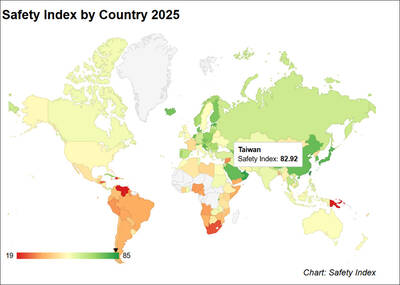The "Asian Brown Cloud," a 3km-thick blanket of pollution over South Asia, may be causing the premature deaths of a half-million people in India each year, deadly flooding in some areas and drought in others, according to the biggest-ever scientific study of the phenomenon.
The grimy cocktail of ash, soot, acids and other damaging airborne particles is as much the result of low-tech polluters like wood- and dung-burning stoves, cooking fires and forest clearing as it is of dirty industries, the UN-sponsored study found.
"When you think about air pollution, many people think of industry and fossil fuels as the only causes," report co-author Paul Crutzen, a scientist at the Max-Planck Institute for Chemistry in Mainz, Germany, told a news conference in London.
Often ignored, he said, was "biomass burning," including forest fires and the burning of vegetation to clear land or to warm the homes of poor people.
More than 200 scientists contributed to the study, overseen by the UN Environment Program in preparation for the World Summit on sustainable Development opening Aug. 26 in Johannesburg, South Africa. They used data from ships, planes and satellites to study Asia's haze from 1995 to 2000.
The scientists say more research is needed but that some trends are clear. Respiratory illness appears to be increasing along with the pollution in densely populated South Asia, with one study suggesting the pollution causes as many as 500,000 premature deaths annually in India.
The dense cloud of pollution -- also caused by auto emissions, factories and waste incineration -- cuts the amount of sunlight reaching the ground and the oceans by 10 percent to 15 percent, cooling the land and water while heating the atmosphere.
That phenomenon appears to have altered the region's monsoon rains -- increasing rainfall and flooding in Bangladesh, Nepal and northeastern India, while cutting back needed seasonal precipitation in Pakistan and northwestern India.
Floods, drought, sunlight reduction and acid rain all can hurt agricultural yields, with the report indicating the pollution may be cutting India's winter rice harvest by as much as 10 percent.
Veerabhadran Ramanathan of the Scripps Institution of Oceanography in La Jolla, California, one of the report's authors, said the extent of the sunlight loss was "a major surprise."
Scientists say it's too early to draw definite conclusions about the impact of the cloud, and of similar hazes over East Asia, South America and Africa.
"We need much more basic scientific data to be able to establish what are the consequences for human health and the environment," said co-author Crutzen, co-winner of the 1995 Nobel chemistry prize for his work on the ozone layer.
But they warn the impact could be global since prevailing winds can push pollution clouds halfway round the world within a week.
It's unclear what the haze's relationship is to global warming, which most scientists believe is caused by the emission of greenhouse gases that trap the Earth's heat. The pollution cloud appears to cool the area below by blocking sunlight.

AIR SUPPORT: The Ministry of National Defense thanked the US for the delivery, adding that it was an indicator of the White House’s commitment to the Taiwan Relations Act Deputy Minister of National Defense Po Horng-huei (柏鴻輝) and Representative to the US Alexander Yui on Friday attended a delivery ceremony for the first of Taiwan’s long-awaited 66 F-16C/D Block 70 jets at a Lockheed Martin Corp factory in Greenville, South Carolina. “We are so proud to be the global home of the F-16 and to support Taiwan’s air defense capabilities,” US Representative William Timmons wrote on X, alongside a photograph of Taiwanese and US officials at the event. The F-16C/D Block 70 jets Taiwan ordered have the same capabilities as aircraft that had been upgraded to F-16Vs. The batch of Lockheed Martin

GRIDLOCK: The National Fire Agency’s Special Search and Rescue team is on standby to travel to the countries to help out with the rescue effort A powerful earthquake rocked Myanmar and neighboring Thailand yesterday, killing at least three people in Bangkok and burying dozens when a high-rise building under construction collapsed. Footage shared on social media from Myanmar’s second-largest city showed widespread destruction, raising fears that many were trapped under the rubble or killed. The magnitude 7.7 earthquake, with an epicenter near Mandalay in Myanmar, struck at midday and was followed by a strong magnitude 6.4 aftershock. The extent of death, injury and destruction — especially in Myanmar, which is embroiled in a civil war and where information is tightly controlled at the best of times —

Taiwan was ranked the fourth-safest country in the world with a score of 82.9, trailing only Andorra, the United Arab Emirates and Qatar in Numbeo’s Safety Index by Country report. Taiwan’s score improved by 0.1 points compared with last year’s mid-year report, which had Taiwan fourth with a score of 82.8. However, both scores were lower than in last year’s first review, when Taiwan scored 83.3, and are a long way from when Taiwan was named the second-safest country in the world in 2021, scoring 84.8. Taiwan ranked higher than Singapore in ninth with a score of 77.4 and Japan in 10th with

China's military today said it began joint army, navy and rocket force exercises around Taiwan to "serve as a stern warning and powerful deterrent against Taiwanese independence," calling President William Lai (賴清德) a "parasite." The exercises come after Lai called Beijing a "foreign hostile force" last month. More than 10 Chinese military ships approached close to Taiwan's 24 nautical mile (44.4km) contiguous zone this morning and Taiwan sent its own warships to respond, two senior Taiwanese officials said. Taiwan has not yet detected any live fire by the Chinese military so far, one of the officials said. The drills took place after US Secretary